Business Case Analysis: Commonwealth Bank of Australia (MGMT20144)
VerifiedAdded on 2022/09/14
|9
|2038
|17
Report
AI Summary
This report provides a comprehensive business case analysis of the Commonwealth Bank of Australia (CBA). It begins with an introduction and organization synopsis, highlighting the bank's formation and objectives. The analysis delves into the CBA's business and governance structure, outlining its role as a multinational bank offering various financial services, and its governance model. The report then employs a PESTEL analysis to examine the environmental factors impacting CBA, including weather, climate change, and regulatory standards. Furthermore, it assesses the risks faced by CBA, such as falling AUD, capital requirements, and the impact of tech giants. The report concludes by emphasizing the importance of strategic adaptation and technological advancements for CBA's continued success in the competitive banking sector. The report uses multiple references to support the analysis and findings.
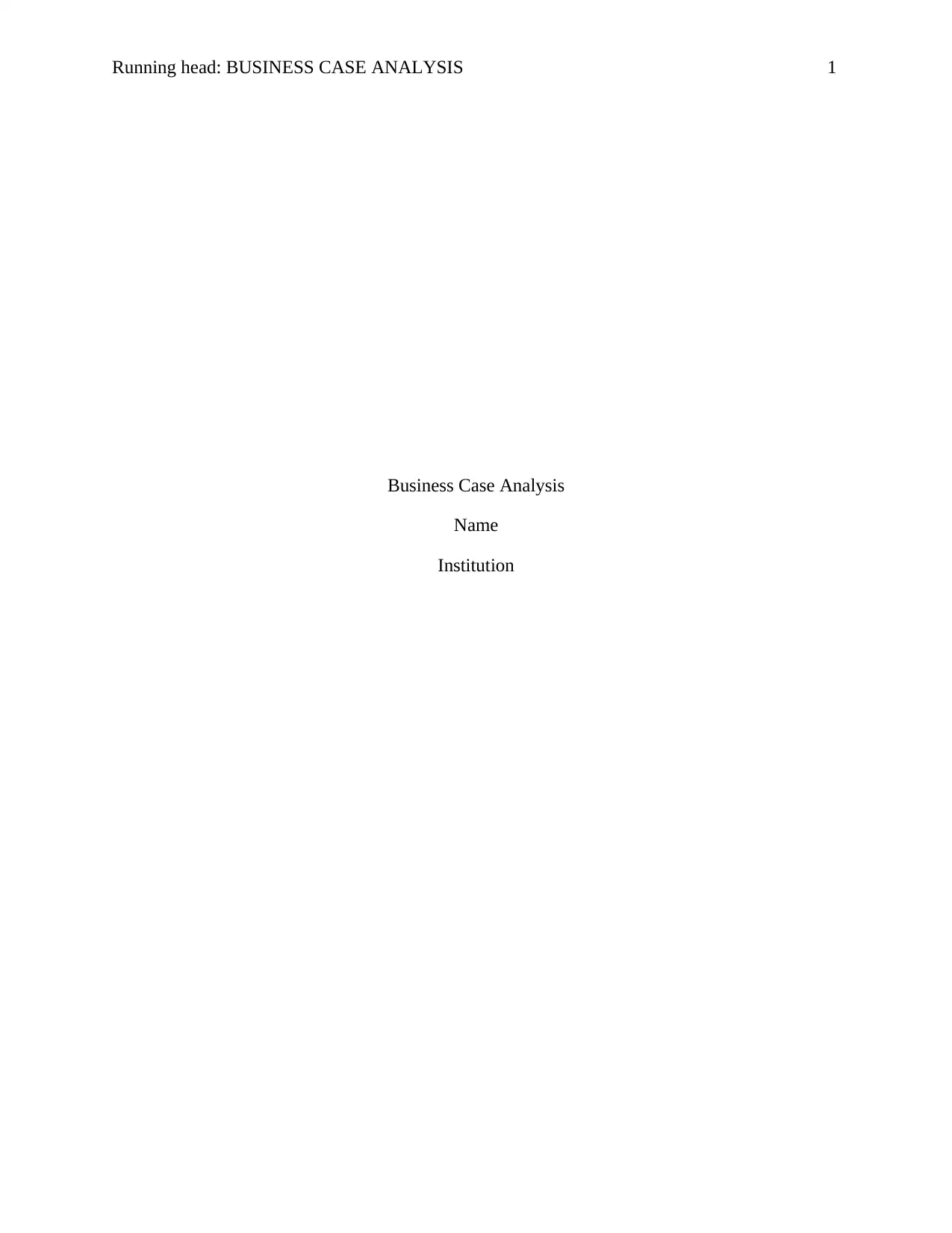
Running head: BUSINESS CASE ANALYSIS 1
Business Case Analysis
Name
Institution
Business Case Analysis
Name
Institution
Paraphrase This Document
Need a fresh take? Get an instant paraphrase of this document with our AI Paraphraser
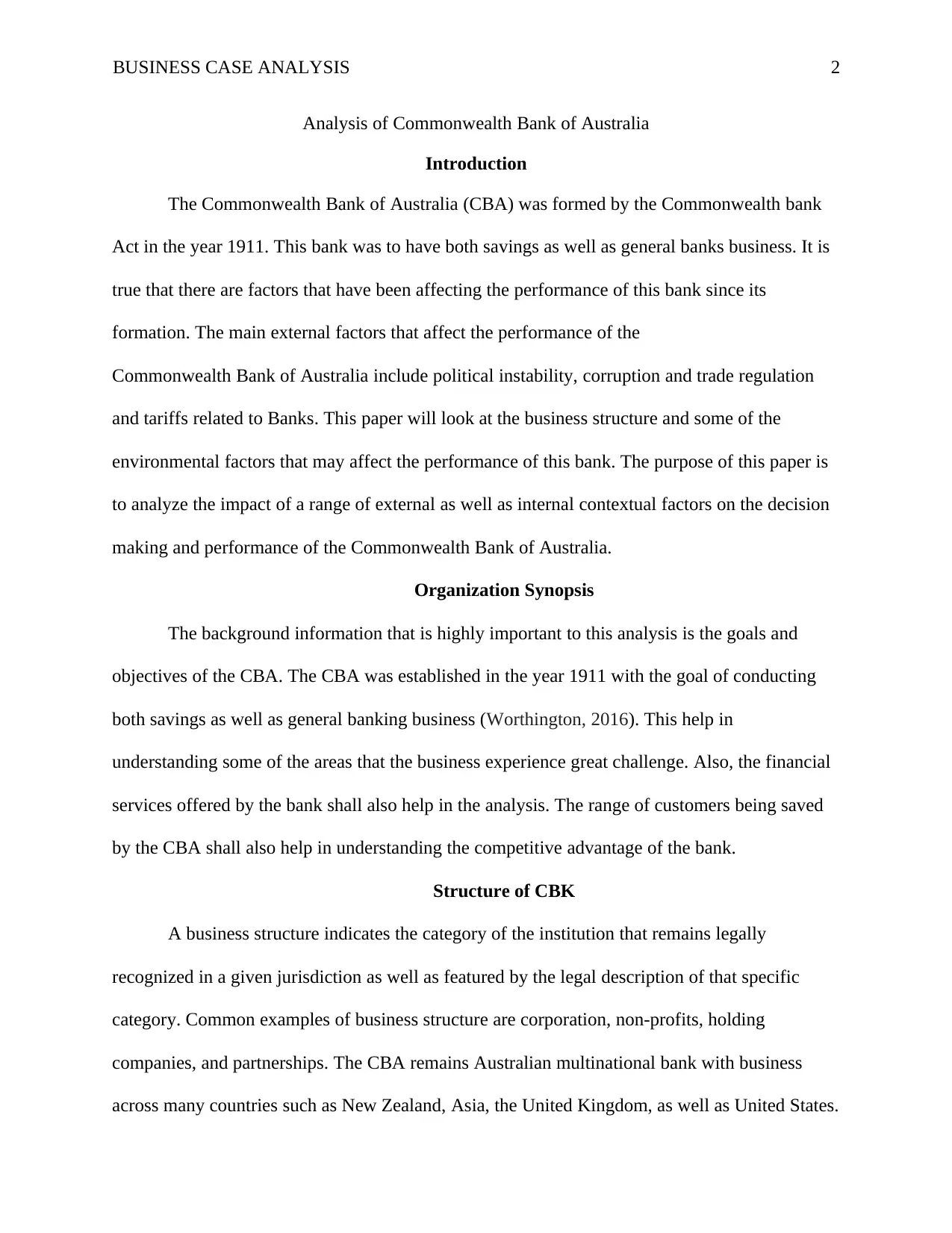
BUSINESS CASE ANALYSIS 2
Analysis of Commonwealth Bank of Australia
Introduction
The Commonwealth Bank of Australia (CBA) was formed by the Commonwealth bank
Act in the year 1911. This bank was to have both savings as well as general banks business. It is
true that there are factors that have been affecting the performance of this bank since its
formation. The main external factors that affect the performance of the
Commonwealth Bank of Australia include political instability, corruption and trade regulation
and tariffs related to Banks. This paper will look at the business structure and some of the
environmental factors that may affect the performance of this bank. The purpose of this paper is
to analyze the impact of a range of external as well as internal contextual factors on the decision
making and performance of the Commonwealth Bank of Australia.
Organization Synopsis
The background information that is highly important to this analysis is the goals and
objectives of the CBA. The CBA was established in the year 1911 with the goal of conducting
both savings as well as general banking business (Worthington, 2016). This help in
understanding some of the areas that the business experience great challenge. Also, the financial
services offered by the bank shall also help in the analysis. The range of customers being saved
by the CBA shall also help in understanding the competitive advantage of the bank.
Structure of CBK
A business structure indicates the category of the institution that remains legally
recognized in a given jurisdiction as well as featured by the legal description of that specific
category. Common examples of business structure are corporation, non-profits, holding
companies, and partnerships. The CBA remains Australian multinational bank with business
across many countries such as New Zealand, Asia, the United Kingdom, as well as United States.
Analysis of Commonwealth Bank of Australia
Introduction
The Commonwealth Bank of Australia (CBA) was formed by the Commonwealth bank
Act in the year 1911. This bank was to have both savings as well as general banks business. It is
true that there are factors that have been affecting the performance of this bank since its
formation. The main external factors that affect the performance of the
Commonwealth Bank of Australia include political instability, corruption and trade regulation
and tariffs related to Banks. This paper will look at the business structure and some of the
environmental factors that may affect the performance of this bank. The purpose of this paper is
to analyze the impact of a range of external as well as internal contextual factors on the decision
making and performance of the Commonwealth Bank of Australia.
Organization Synopsis
The background information that is highly important to this analysis is the goals and
objectives of the CBA. The CBA was established in the year 1911 with the goal of conducting
both savings as well as general banking business (Worthington, 2016). This help in
understanding some of the areas that the business experience great challenge. Also, the financial
services offered by the bank shall also help in the analysis. The range of customers being saved
by the CBA shall also help in understanding the competitive advantage of the bank.
Structure of CBK
A business structure indicates the category of the institution that remains legally
recognized in a given jurisdiction as well as featured by the legal description of that specific
category. Common examples of business structure are corporation, non-profits, holding
companies, and partnerships. The CBA remains Australian multinational bank with business
across many countries such as New Zealand, Asia, the United Kingdom, as well as United States.
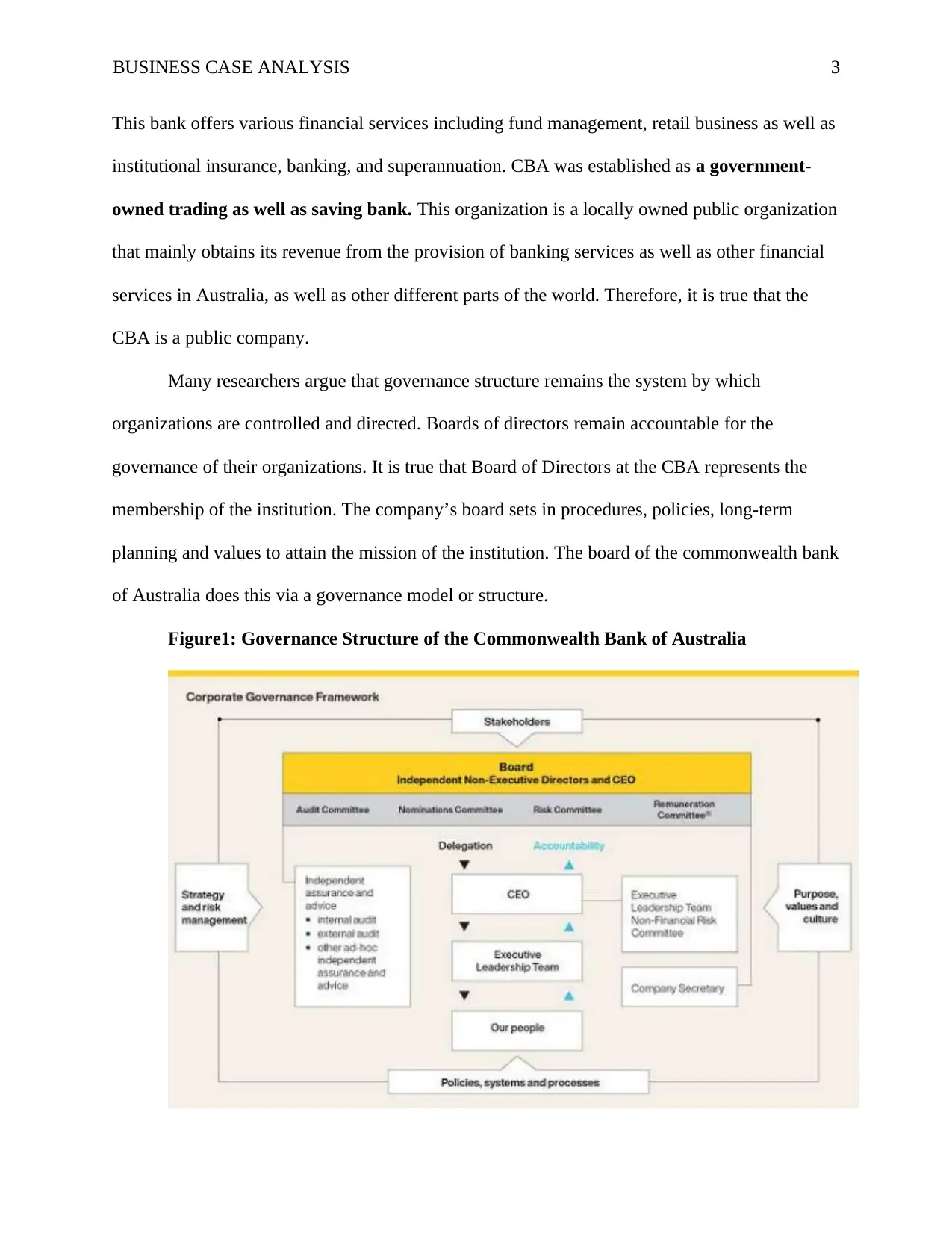
BUSINESS CASE ANALYSIS 3
This bank offers various financial services including fund management, retail business as well as
institutional insurance, banking, and superannuation. CBA was established as a government-
owned trading as well as saving bank. This organization is a locally owned public organization
that mainly obtains its revenue from the provision of banking services as well as other financial
services in Australia, as well as other different parts of the world. Therefore, it is true that the
CBA is a public company.
Many researchers argue that governance structure remains the system by which
organizations are controlled and directed. Boards of directors remain accountable for the
governance of their organizations. It is true that Board of Directors at the CBA represents the
membership of the institution. The company’s board sets in procedures, policies, long-term
planning and values to attain the mission of the institution. The board of the commonwealth bank
of Australia does this via a governance model or structure.
Figure1: Governance Structure of the Commonwealth Bank of Australia
This bank offers various financial services including fund management, retail business as well as
institutional insurance, banking, and superannuation. CBA was established as a government-
owned trading as well as saving bank. This organization is a locally owned public organization
that mainly obtains its revenue from the provision of banking services as well as other financial
services in Australia, as well as other different parts of the world. Therefore, it is true that the
CBA is a public company.
Many researchers argue that governance structure remains the system by which
organizations are controlled and directed. Boards of directors remain accountable for the
governance of their organizations. It is true that Board of Directors at the CBA represents the
membership of the institution. The company’s board sets in procedures, policies, long-term
planning and values to attain the mission of the institution. The board of the commonwealth bank
of Australia does this via a governance model or structure.
Figure1: Governance Structure of the Commonwealth Bank of Australia
⊘ This is a preview!⊘
Do you want full access?
Subscribe today to unlock all pages.

Trusted by 1+ million students worldwide
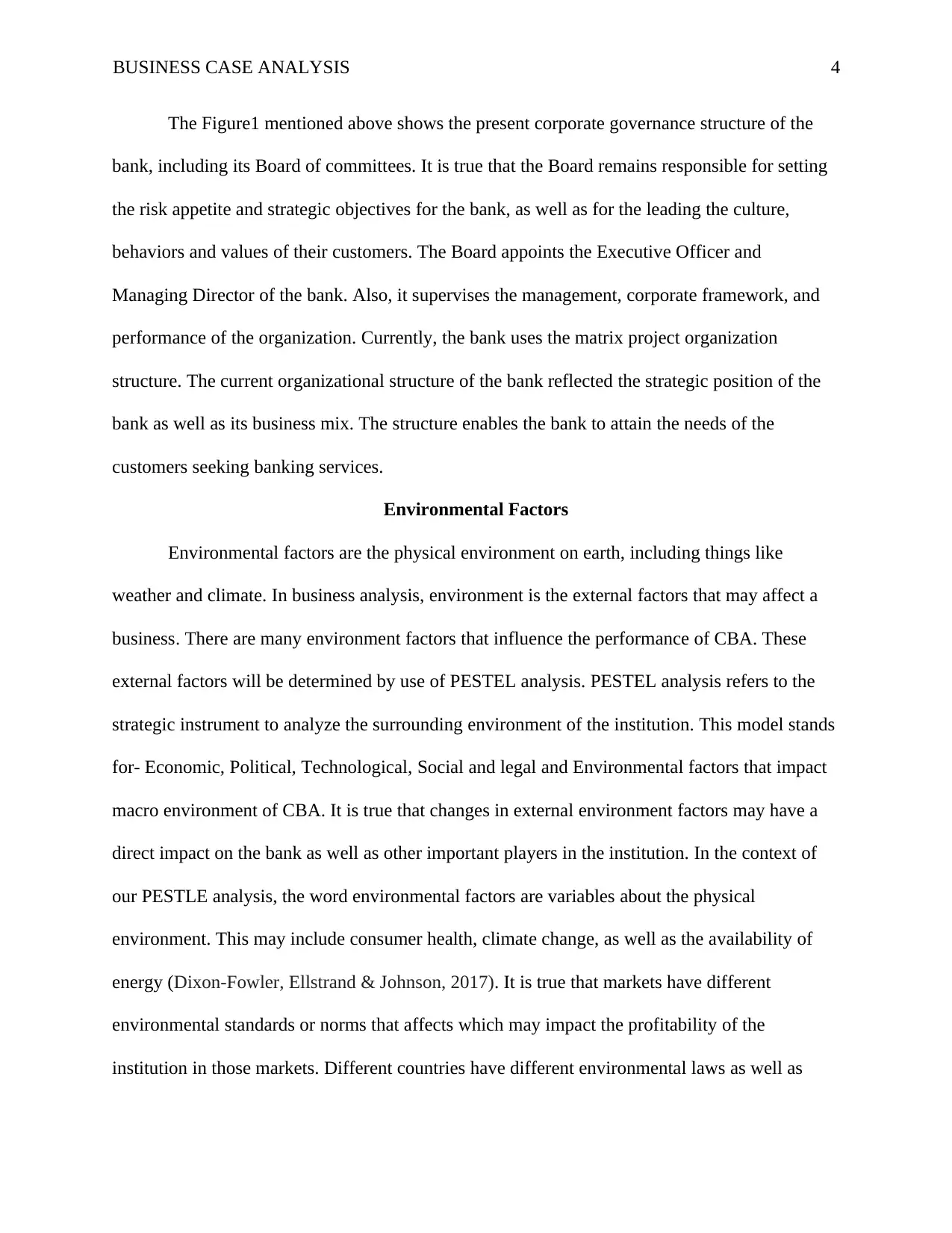
BUSINESS CASE ANALYSIS 4
The Figure1 mentioned above shows the present corporate governance structure of the
bank, including its Board of committees. It is true that the Board remains responsible for setting
the risk appetite and strategic objectives for the bank, as well as for the leading the culture,
behaviors and values of their customers. The Board appoints the Executive Officer and
Managing Director of the bank. Also, it supervises the management, corporate framework, and
performance of the organization. Currently, the bank uses the matrix project organization
structure. The current organizational structure of the bank reflected the strategic position of the
bank as well as its business mix. The structure enables the bank to attain the needs of the
customers seeking banking services.
Environmental Factors
Environmental factors are the physical environment on earth, including things like
weather and climate. In business analysis, environment is the external factors that may affect a
business. There are many environment factors that influence the performance of CBA. These
external factors will be determined by use of PESTEL analysis. PESTEL analysis refers to the
strategic instrument to analyze the surrounding environment of the institution. This model stands
for- Economic, Political, Technological, Social and legal and Environmental factors that impact
macro environment of CBA. It is true that changes in external environment factors may have a
direct impact on the bank as well as other important players in the institution. In the context of
our PESTLE analysis, the word environmental factors are variables about the physical
environment. This may include consumer health, climate change, as well as the availability of
energy (Dixon-Fowler, Ellstrand & Johnson, 2017). It is true that markets have different
environmental standards or norms that affects which may impact the profitability of the
institution in those markets. Different countries have different environmental laws as well as
The Figure1 mentioned above shows the present corporate governance structure of the
bank, including its Board of committees. It is true that the Board remains responsible for setting
the risk appetite and strategic objectives for the bank, as well as for the leading the culture,
behaviors and values of their customers. The Board appoints the Executive Officer and
Managing Director of the bank. Also, it supervises the management, corporate framework, and
performance of the organization. Currently, the bank uses the matrix project organization
structure. The current organizational structure of the bank reflected the strategic position of the
bank as well as its business mix. The structure enables the bank to attain the needs of the
customers seeking banking services.
Environmental Factors
Environmental factors are the physical environment on earth, including things like
weather and climate. In business analysis, environment is the external factors that may affect a
business. There are many environment factors that influence the performance of CBA. These
external factors will be determined by use of PESTEL analysis. PESTEL analysis refers to the
strategic instrument to analyze the surrounding environment of the institution. This model stands
for- Economic, Political, Technological, Social and legal and Environmental factors that impact
macro environment of CBA. It is true that changes in external environment factors may have a
direct impact on the bank as well as other important players in the institution. In the context of
our PESTLE analysis, the word environmental factors are variables about the physical
environment. This may include consumer health, climate change, as well as the availability of
energy (Dixon-Fowler, Ellstrand & Johnson, 2017). It is true that markets have different
environmental standards or norms that affects which may impact the profitability of the
institution in those markets. Different countries have different environmental laws as well as
Paraphrase This Document
Need a fresh take? Get an instant paraphrase of this document with our AI Paraphraser
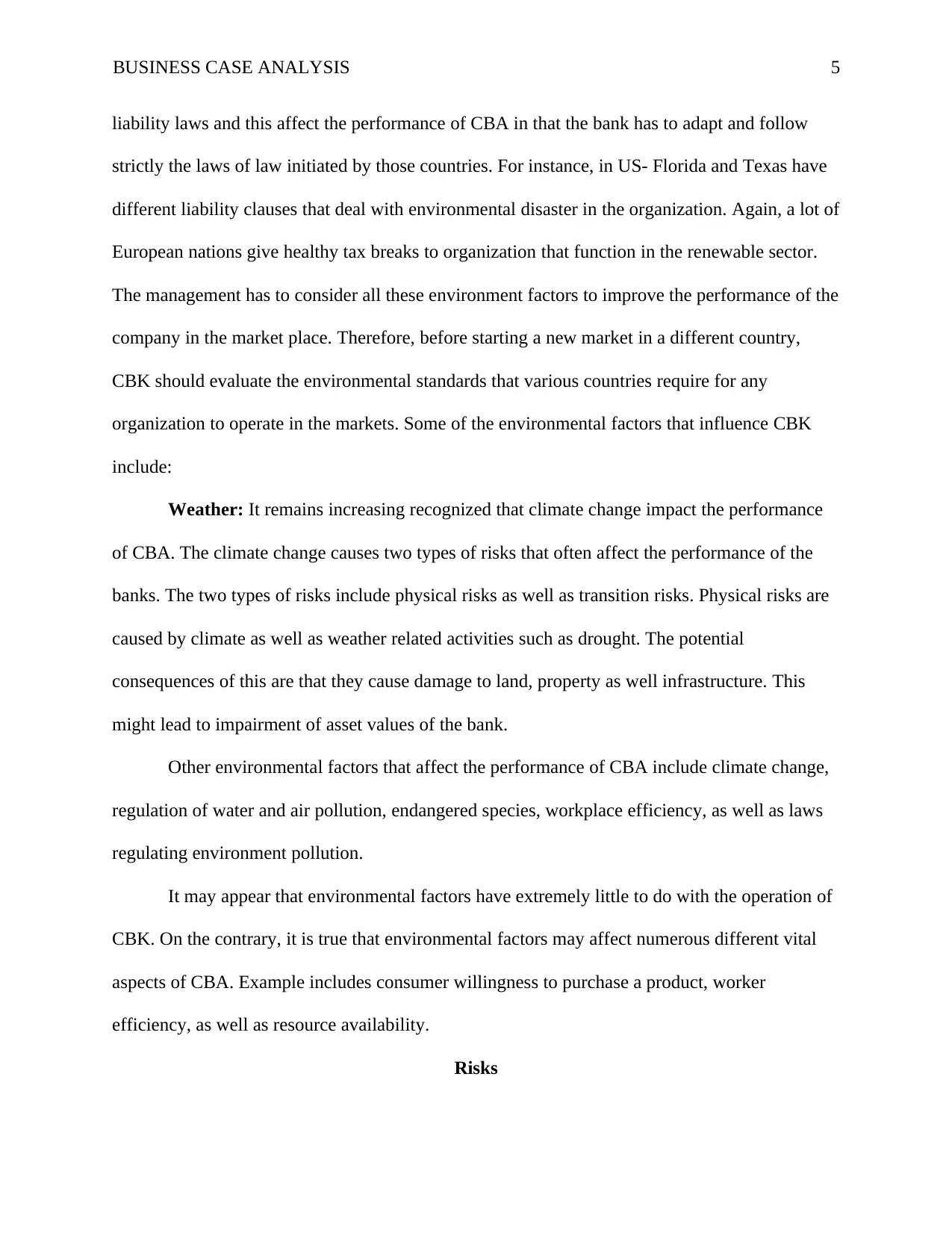
BUSINESS CASE ANALYSIS 5
liability laws and this affect the performance of CBA in that the bank has to adapt and follow
strictly the laws of law initiated by those countries. For instance, in US- Florida and Texas have
different liability clauses that deal with environmental disaster in the organization. Again, a lot of
European nations give healthy tax breaks to organization that function in the renewable sector.
The management has to consider all these environment factors to improve the performance of the
company in the market place. Therefore, before starting a new market in a different country,
CBK should evaluate the environmental standards that various countries require for any
organization to operate in the markets. Some of the environmental factors that influence CBK
include:
Weather: It remains increasing recognized that climate change impact the performance
of CBA. The climate change causes two types of risks that often affect the performance of the
banks. The two types of risks include physical risks as well as transition risks. Physical risks are
caused by climate as well as weather related activities such as drought. The potential
consequences of this are that they cause damage to land, property as well infrastructure. This
might lead to impairment of asset values of the bank.
Other environmental factors that affect the performance of CBA include climate change,
regulation of water and air pollution, endangered species, workplace efficiency, as well as laws
regulating environment pollution.
It may appear that environmental factors have extremely little to do with the operation of
CBK. On the contrary, it is true that environmental factors may affect numerous different vital
aspects of CBA. Example includes consumer willingness to purchase a product, worker
efficiency, as well as resource availability.
Risks
liability laws and this affect the performance of CBA in that the bank has to adapt and follow
strictly the laws of law initiated by those countries. For instance, in US- Florida and Texas have
different liability clauses that deal with environmental disaster in the organization. Again, a lot of
European nations give healthy tax breaks to organization that function in the renewable sector.
The management has to consider all these environment factors to improve the performance of the
company in the market place. Therefore, before starting a new market in a different country,
CBK should evaluate the environmental standards that various countries require for any
organization to operate in the markets. Some of the environmental factors that influence CBK
include:
Weather: It remains increasing recognized that climate change impact the performance
of CBA. The climate change causes two types of risks that often affect the performance of the
banks. The two types of risks include physical risks as well as transition risks. Physical risks are
caused by climate as well as weather related activities such as drought. The potential
consequences of this are that they cause damage to land, property as well infrastructure. This
might lead to impairment of asset values of the bank.
Other environmental factors that affect the performance of CBA include climate change,
regulation of water and air pollution, endangered species, workplace efficiency, as well as laws
regulating environment pollution.
It may appear that environmental factors have extremely little to do with the operation of
CBK. On the contrary, it is true that environmental factors may affect numerous different vital
aspects of CBA. Example includes consumer willingness to purchase a product, worker
efficiency, as well as resource availability.
Risks
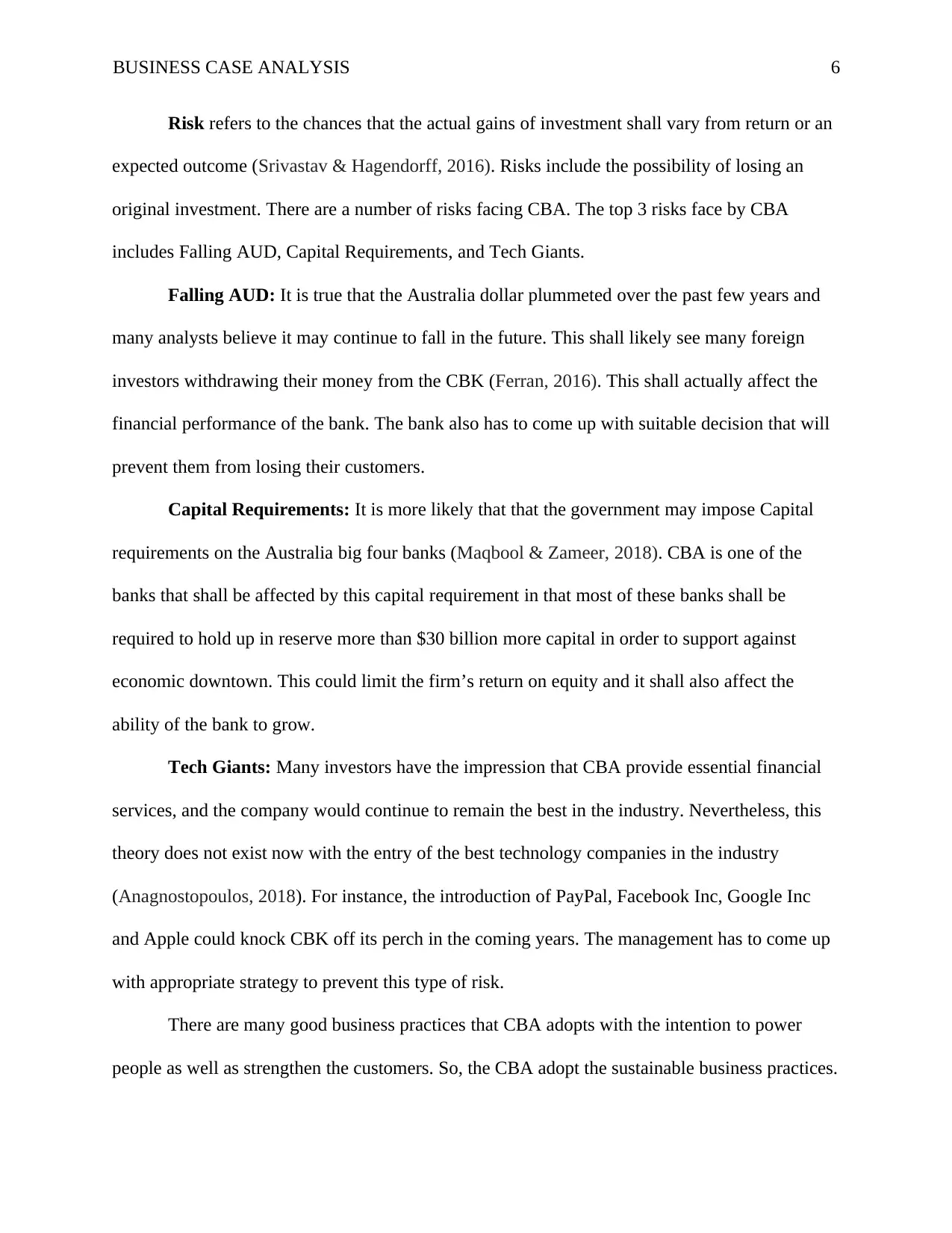
BUSINESS CASE ANALYSIS 6
Risk refers to the chances that the actual gains of investment shall vary from return or an
expected outcome (Srivastav & Hagendorff, 2016). Risks include the possibility of losing an
original investment. There are a number of risks facing CBA. The top 3 risks face by CBA
includes Falling AUD, Capital Requirements, and Tech Giants.
Falling AUD: It is true that the Australia dollar plummeted over the past few years and
many analysts believe it may continue to fall in the future. This shall likely see many foreign
investors withdrawing their money from the CBK (Ferran, 2016). This shall actually affect the
financial performance of the bank. The bank also has to come up with suitable decision that will
prevent them from losing their customers.
Capital Requirements: It is more likely that that the government may impose Capital
requirements on the Australia big four banks (Maqbool & Zameer, 2018). CBA is one of the
banks that shall be affected by this capital requirement in that most of these banks shall be
required to hold up in reserve more than $30 billion more capital in order to support against
economic downtown. This could limit the firm’s return on equity and it shall also affect the
ability of the bank to grow.
Tech Giants: Many investors have the impression that CBA provide essential financial
services, and the company would continue to remain the best in the industry. Nevertheless, this
theory does not exist now with the entry of the best technology companies in the industry
(Anagnostopoulos, 2018). For instance, the introduction of PayPal, Facebook Inc, Google Inc
and Apple could knock CBK off its perch in the coming years. The management has to come up
with appropriate strategy to prevent this type of risk.
There are many good business practices that CBA adopts with the intention to power
people as well as strengthen the customers. So, the CBA adopt the sustainable business practices.
Risk refers to the chances that the actual gains of investment shall vary from return or an
expected outcome (Srivastav & Hagendorff, 2016). Risks include the possibility of losing an
original investment. There are a number of risks facing CBA. The top 3 risks face by CBA
includes Falling AUD, Capital Requirements, and Tech Giants.
Falling AUD: It is true that the Australia dollar plummeted over the past few years and
many analysts believe it may continue to fall in the future. This shall likely see many foreign
investors withdrawing their money from the CBK (Ferran, 2016). This shall actually affect the
financial performance of the bank. The bank also has to come up with suitable decision that will
prevent them from losing their customers.
Capital Requirements: It is more likely that that the government may impose Capital
requirements on the Australia big four banks (Maqbool & Zameer, 2018). CBA is one of the
banks that shall be affected by this capital requirement in that most of these banks shall be
required to hold up in reserve more than $30 billion more capital in order to support against
economic downtown. This could limit the firm’s return on equity and it shall also affect the
ability of the bank to grow.
Tech Giants: Many investors have the impression that CBA provide essential financial
services, and the company would continue to remain the best in the industry. Nevertheless, this
theory does not exist now with the entry of the best technology companies in the industry
(Anagnostopoulos, 2018). For instance, the introduction of PayPal, Facebook Inc, Google Inc
and Apple could knock CBK off its perch in the coming years. The management has to come up
with appropriate strategy to prevent this type of risk.
There are many good business practices that CBA adopts with the intention to power
people as well as strengthen the customers. So, the CBA adopt the sustainable business practices.
⊘ This is a preview!⊘
Do you want full access?
Subscribe today to unlock all pages.

Trusted by 1+ million students worldwide
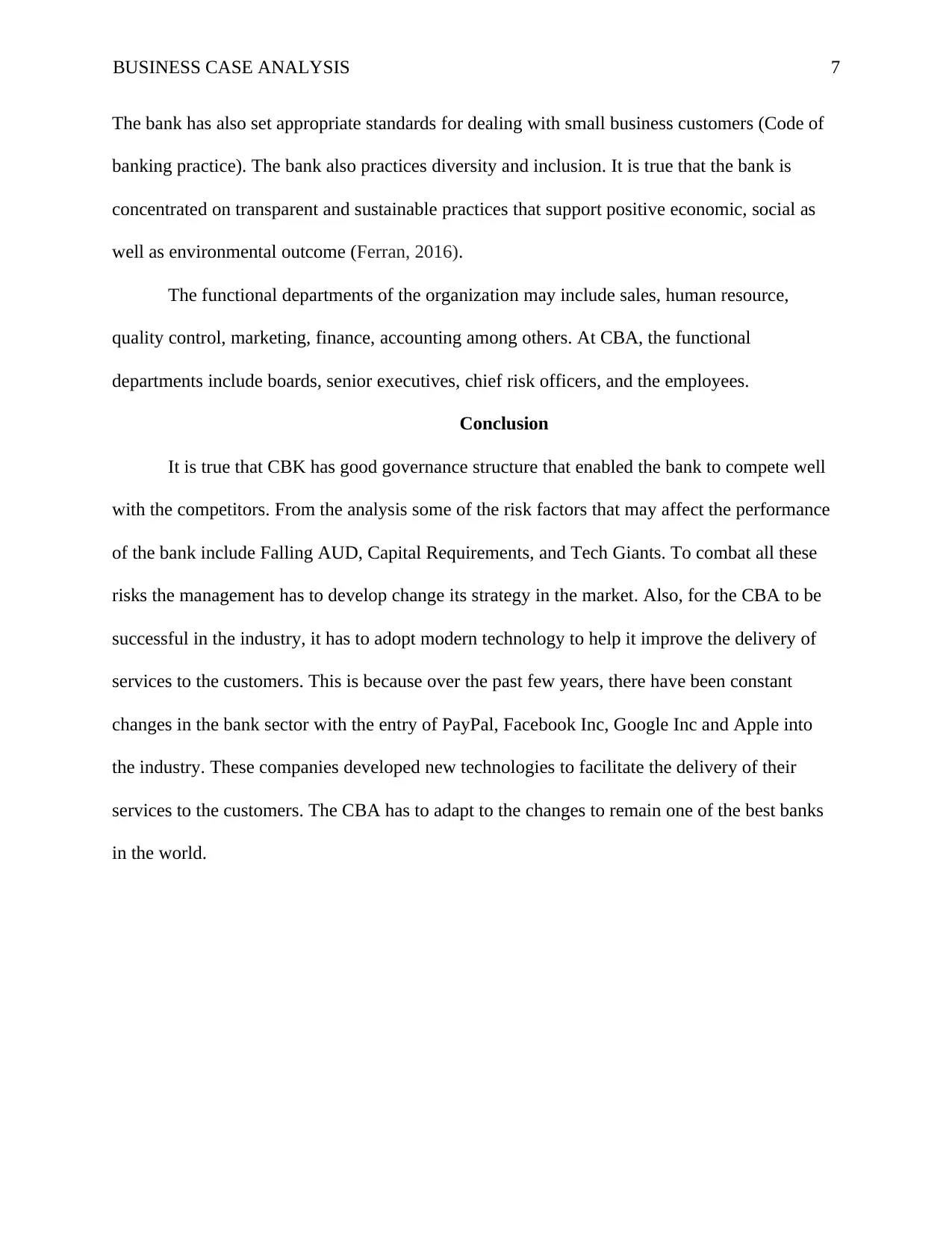
BUSINESS CASE ANALYSIS 7
The bank has also set appropriate standards for dealing with small business customers (Code of
banking practice). The bank also practices diversity and inclusion. It is true that the bank is
concentrated on transparent and sustainable practices that support positive economic, social as
well as environmental outcome (Ferran, 2016).
The functional departments of the organization may include sales, human resource,
quality control, marketing, finance, accounting among others. At CBA, the functional
departments include boards, senior executives, chief risk officers, and the employees.
Conclusion
It is true that CBK has good governance structure that enabled the bank to compete well
with the competitors. From the analysis some of the risk factors that may affect the performance
of the bank include Falling AUD, Capital Requirements, and Tech Giants. To combat all these
risks the management has to develop change its strategy in the market. Also, for the CBA to be
successful in the industry, it has to adopt modern technology to help it improve the delivery of
services to the customers. This is because over the past few years, there have been constant
changes in the bank sector with the entry of PayPal, Facebook Inc, Google Inc and Apple into
the industry. These companies developed new technologies to facilitate the delivery of their
services to the customers. The CBA has to adapt to the changes to remain one of the best banks
in the world.
The bank has also set appropriate standards for dealing with small business customers (Code of
banking practice). The bank also practices diversity and inclusion. It is true that the bank is
concentrated on transparent and sustainable practices that support positive economic, social as
well as environmental outcome (Ferran, 2016).
The functional departments of the organization may include sales, human resource,
quality control, marketing, finance, accounting among others. At CBA, the functional
departments include boards, senior executives, chief risk officers, and the employees.
Conclusion
It is true that CBK has good governance structure that enabled the bank to compete well
with the competitors. From the analysis some of the risk factors that may affect the performance
of the bank include Falling AUD, Capital Requirements, and Tech Giants. To combat all these
risks the management has to develop change its strategy in the market. Also, for the CBA to be
successful in the industry, it has to adopt modern technology to help it improve the delivery of
services to the customers. This is because over the past few years, there have been constant
changes in the bank sector with the entry of PayPal, Facebook Inc, Google Inc and Apple into
the industry. These companies developed new technologies to facilitate the delivery of their
services to the customers. The CBA has to adapt to the changes to remain one of the best banks
in the world.
Paraphrase This Document
Need a fresh take? Get an instant paraphrase of this document with our AI Paraphraser
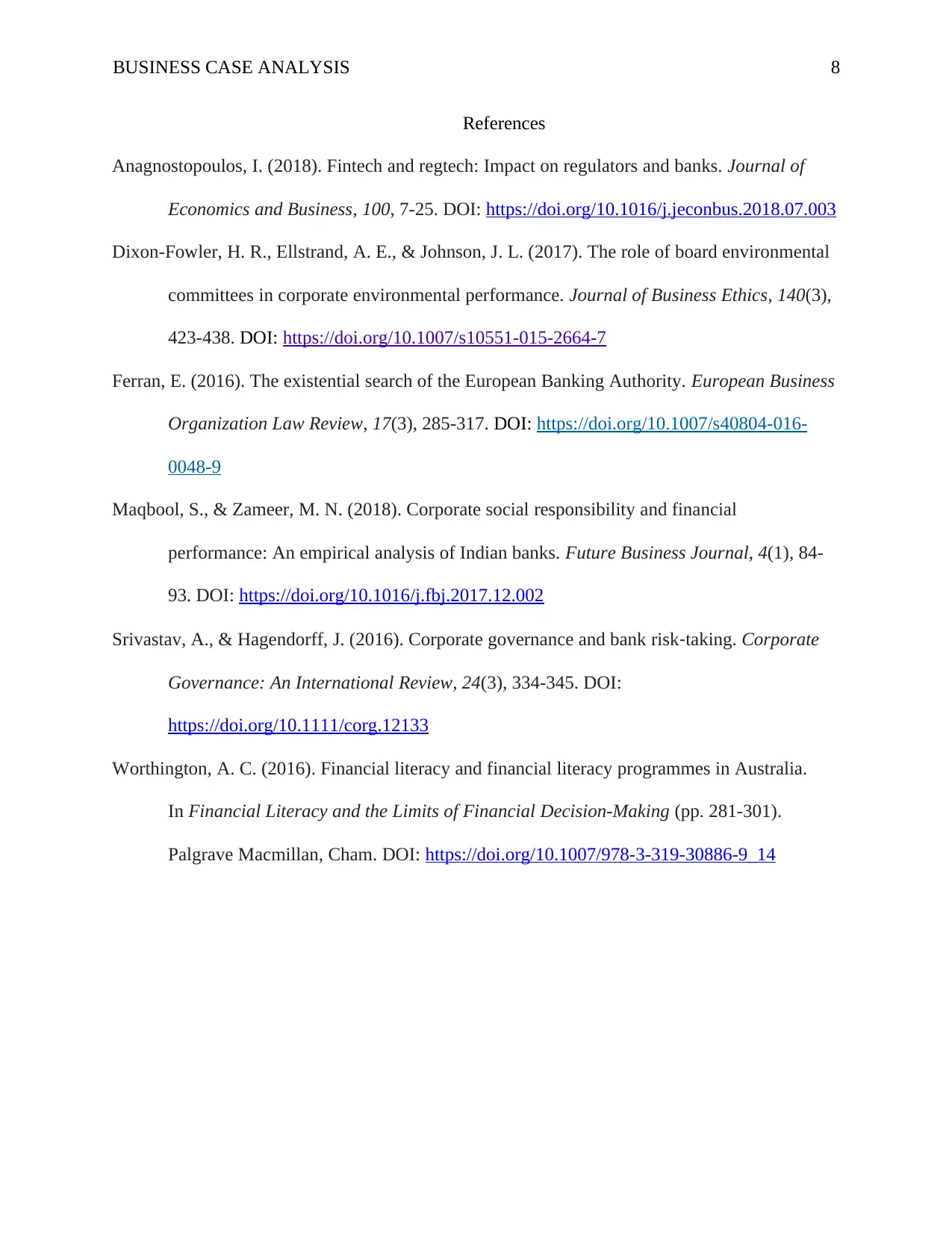
BUSINESS CASE ANALYSIS 8
References
Anagnostopoulos, I. (2018). Fintech and regtech: Impact on regulators and banks. Journal of
Economics and Business, 100, 7-25. DOI: https://doi.org/10.1016/j.jeconbus.2018.07.003
Dixon-Fowler, H. R., Ellstrand, A. E., & Johnson, J. L. (2017). The role of board environmental
committees in corporate environmental performance. Journal of Business Ethics, 140(3),
423-438. DOI: https://doi.org/10.1007/s10551-015-2664-7
Ferran, E. (2016). The existential search of the European Banking Authority. European Business
Organization Law Review, 17(3), 285-317. DOI: https://doi.org/10.1007/s40804-016-
0048-9
Maqbool, S., & Zameer, M. N. (2018). Corporate social responsibility and financial
performance: An empirical analysis of Indian banks. Future Business Journal, 4(1), 84-
93. DOI: https://doi.org/10.1016/j.fbj.2017.12.002
Srivastav, A., & Hagendorff, J. (2016). Corporate governance and bank risk‐taking. Corporate
Governance: An International Review, 24(3), 334-345. DOI:
https://doi.org/10.1111/corg.12133
Worthington, A. C. (2016). Financial literacy and financial literacy programmes in Australia.
In Financial Literacy and the Limits of Financial Decision-Making (pp. 281-301).
Palgrave Macmillan, Cham. DOI: https://doi.org/10.1007/978-3-319-30886-9_14
References
Anagnostopoulos, I. (2018). Fintech and regtech: Impact on regulators and banks. Journal of
Economics and Business, 100, 7-25. DOI: https://doi.org/10.1016/j.jeconbus.2018.07.003
Dixon-Fowler, H. R., Ellstrand, A. E., & Johnson, J. L. (2017). The role of board environmental
committees in corporate environmental performance. Journal of Business Ethics, 140(3),
423-438. DOI: https://doi.org/10.1007/s10551-015-2664-7
Ferran, E. (2016). The existential search of the European Banking Authority. European Business
Organization Law Review, 17(3), 285-317. DOI: https://doi.org/10.1007/s40804-016-
0048-9
Maqbool, S., & Zameer, M. N. (2018). Corporate social responsibility and financial
performance: An empirical analysis of Indian banks. Future Business Journal, 4(1), 84-
93. DOI: https://doi.org/10.1016/j.fbj.2017.12.002
Srivastav, A., & Hagendorff, J. (2016). Corporate governance and bank risk‐taking. Corporate
Governance: An International Review, 24(3), 334-345. DOI:
https://doi.org/10.1111/corg.12133
Worthington, A. C. (2016). Financial literacy and financial literacy programmes in Australia.
In Financial Literacy and the Limits of Financial Decision-Making (pp. 281-301).
Palgrave Macmillan, Cham. DOI: https://doi.org/10.1007/978-3-319-30886-9_14

BUSINESS CASE ANALYSIS 9
⊘ This is a preview!⊘
Do you want full access?
Subscribe today to unlock all pages.

Trusted by 1+ million students worldwide
1 out of 9
Related Documents
Your All-in-One AI-Powered Toolkit for Academic Success.
+13062052269
info@desklib.com
Available 24*7 on WhatsApp / Email
![[object Object]](/_next/static/media/star-bottom.7253800d.svg)
Unlock your academic potential
Copyright © 2020–2025 A2Z Services. All Rights Reserved. Developed and managed by ZUCOL.





